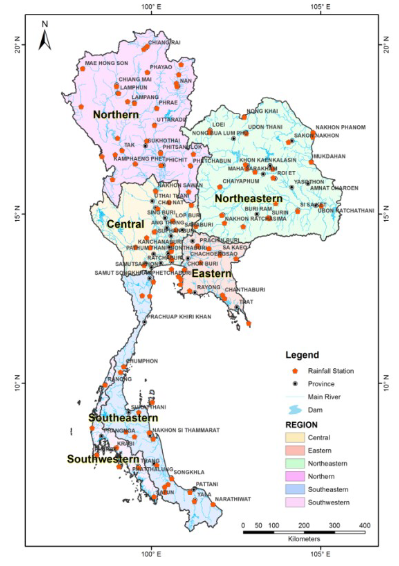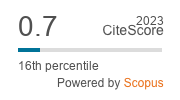A Prediction of Future Drought in Thailand under Changing Climate by Using SPI and SPEI Indices
doi: 10.14456/mijet.2020.12
Keywords:
climate change, gamma-gamma transformation, bias correction, standardized precipitation index, standardized precipitation evaporation indexAbstract
Climate change is the main cause of the water disasters; directly impacted flood and drought that occur from excess and shortage of water in several areas. Drought risk areas have tendency to suffer from greater severity and higher frequency of disaster in future. Therefore, it is necessary to conduct drought prediction in order to understand water stress conditions in drought hotspots or drought prone areas. Meteorological drought indicators can be calculated from rainfall and temperature. The standardized precipitation index (SPI) and standardized precipitation evaporation index (SPEI) are used in temporal analysis of drought severity. This study aims to predict and compare future droughts under changing climate. The observed climate data from weather stations in Thailand and 10 GCM climate datasets under CMIP5 project were used as inputs. The gamma-gamma transformation method was applied to correct biases of GCM precipitation and temperature data. SPI and SPEI indices were calculated for each weather station to describe drought situation. The number of drought events and their severity were calculated and presented on a drought risk map. The consistency index was used to identify hotspot areas from multiple SPI and SPEI results. These results would raise drought awareness of related government agencies in order to prepare the water plans to cope with water shortage in the drought risk areas.
References
Mika, J., Horvath, S., Makra, L. and Dunkel, Z. (2005), The Palmer drought severity index (PDSI) as an indicator of soil moisture. Physics and Chemistry of the Earth, 30: 223–230. https://doi.org/10.1016/j.pce.2004.08.036
World Meteorological Organization, (2012), Standardized Precipitation Index User Guide (M. Svoboda, M. Hayes and D. Wood). (WMO-No. 1090), Geneva, Switzerland.
Vicente-Serrano S.M., Santiago Beguería, Juan I. López-Moreno, (2010), A Multi-scalar drought index sensitive to global warming: The Standardized Precipitation Evapotranspiration Index - SPEI. Journal of Climate., 23: 1696-1718.
http://spei.csic.es/home.html (accessed on 1 February 2020)
Keyantash, J. and J. Dracup., (2002), The quantification of drought: an evaluation of drought indices. Bulletin of the American Meteorological Society., 83: 1167-1180.
Kim, D.W. and H.R. Byun, (2009), Future pattern of Asian drought under global warming scenario. Theoretical and Applied Climatology., 98: 137-150.
Giorgi, F., and X. Bi, (2005), Updated regional precipitation and temperature changes for 21st century from ensembles of recent AOGCM simulations, Geophysical Research Letters., 32: L21715, doi:10.1029/2005GL02-4288
Vuuren, P. D. V., Edmonds, J., Kainuma, M., Riahi, K., Thomson, A., Hibbard, K., Hurtt, G. C., Kram, T., Krey, V., Lamarque, J. F., Masui, T., Meinshausen, M., Nakicenovic, N., Smith, S. J., Rose, S. K., (2011), The representative concentration pathways: an overview, Climatic Change., 109 (1) : 5-31.
Binaya Kumar Mishra, Srikantha Herath, (2014), Assessment of Future Floods in the Bagmati River Basin of Nepal Using Bias-Corrected Daily GCM Precipitation Data Journal of Hydrologic Engineering March 20(8) : 05014027 DOI: 10.1061/(ASCE)HE.1943-5584.0001090
Mishra, B. and Herath, S. (2011), Climate projections downscaling and impact assessment onprecipitation over upper Bagmati River Basin, Nepal. Proc., Int. Conf. on Addressing Climate Change for Sustainable Development through Up-Scaling Renewable Energy Technologies, Institute of Engineering, Tribhuvan Univ., Kathmandu, Nepal : 275–281.
McKee, T.B., Doesken, N.J., and Kleist, J. (1993), The relationship of drought frequency and duration to time scale. In: Proceedings of the Eighth Conference on Applied Climatology, Anaheim, California,17–22 January 1993. Boston, American Meteorological Society : 179–184.
Edwards D.C., McKee T.B., (1997), Characteristics of 20th century drought in the United States at multiple scales, Atmospheric Science, paper no. 634, May 1-30.
Abramowitz M, Stegun A., (1965), Handbook of Mathematical Formulas, Graphs, and Mathematical Tables. Dover Publications. Inc.: New York
Wang, G., (2005), Agriculture drought in a future climate: results from 15 global climate models participating in the IPCC 4th assessment. Clim.Dynam., 25: 739-753.
Kim, D.-W., and H.-R. Byun, (2009), Future pattern of Asian drought under global warming scenario. Theoretical and Applied Climatology., 98 : 137-150.
Willmott, C.J. (1982), Some comments on the evaluation of model performance. Bulletin of the American Meteorological Society 1982; 63: 1309-1313.
Willmott, C.J., Ackleson, S.G., Davis, R.E., Feddema, 938 J.J., Klink, K.M., Legates, D.R., et al. (1985), Statistics for the evaluation and comparison of models. Journal of Geophysical Research: Oceans 1985; 90: 8995-9005.
Willmott, C.J., Matsuura, K. Advantages of the mean absolute error (MAE) over the root mean square error (RMSE) in assessing average model performance. Climate research 2005; 30: 79-82.
Yapo P. O., Gupta H. V., Sorooshian S., (1996), Automatic calibration of conceptual rainfall-runoff models: sensitivity to calibration data. Journal of Hydrology., 181 (i1-4) : 23-48.
Sorooshian, S., Q. Duan, and V. K. Gupta., (1993), Calibration of rainfall-runoff models: Application of global optimization to the Sacramento Soil Moisture Accounting Model, Water Resources Research, 29 (4) : 1185-1194, doi:10.1029/92WR02617.
Roebber, Paul J. (1998), The Regime Dependence of Degree Day Forecast Technique, Skill, and Value, American Meteorological Society -- Weather and Forecasting., 13 (3): 783–794, Bibcode:1998WtFor..13..783R, doi:10.1175/1520-0434(1998)013<0783:TRDODD>2.0.CO;2
Murphy, Allen H. (1988), Skill Scores Based on the Mean Square Error and Their Relationships to the Correlation Coefficient", American Meteorological Society -- Monthly Weather Review, 116 (12): 2417–2424, Bibcode:1988MWRv..116.2417M, doi:10.1175/1520-0493(1988)116<2417:SSBOTM>2.0.CO;2

Downloads
Published
How to Cite
Issue
Section
License
Copyright (c) 2020 Mahasarakham International Journal of Engineering Technology

This work is licensed under a Creative Commons Attribution-NonCommercial-NoDerivatives 4.0 International License.







